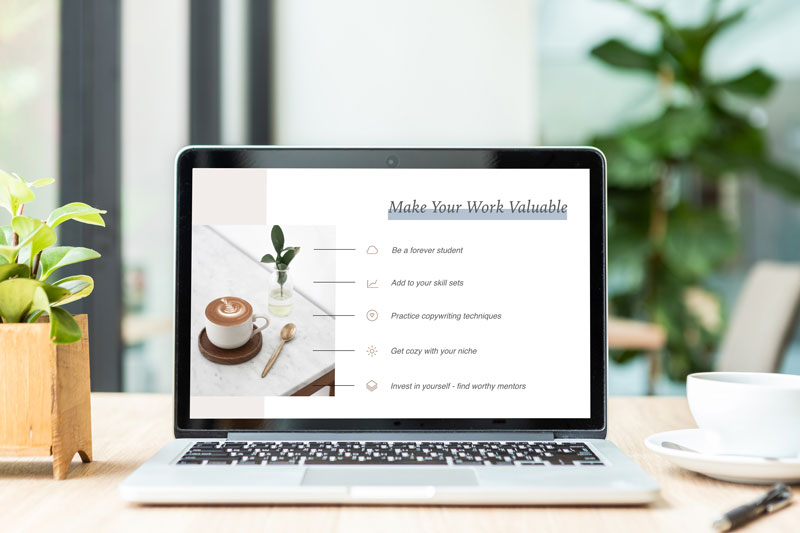Steal this proven sales copy formula to increase your client’s results and land more copywriting projects.

How do you persuade an audience to purchase a product or service?
Even the *best* products don’t simply fly off the shelves on their own. You need strategic marketing and effective sales copywriting to incentivize the audience to buy.
That’s why mastering how to write effective sales copy is an invaluable copywriting skill.
It helps you increase your client’s sales and revenue – leading to happy clients and more projects. Plus, you learn how to promote and sell your own services.
This article provides a deep dive into the art and science of effective sales copywriting, including the different types of sales copy projects you can offer your clients.
I. What Is Sales Copywriting
II. Types of Sales Copywriting
III. Sales Copywriting Anatomy: How to Write Sales Copy
IV. Become a High-Earning Sales Copywriter
My words have driven over $37 million in sales within the service sector. I’ve empowered my client’s brands to generate waiting lists that span multiple years – and amplified their revenue by a whopping ten times!
Ready to master the sales copywriting techniques that can boost both your clients’ revenue and your own career earnings? Let’s dive in!
Learn How to Build a Lucrative Freelance Copywriting Career
Get my free copywriting masterclass that walks you through exactly how I went from zero to consistent five-figure months with copywriting – with no experience and no portfolio.
Gain instant access – right to your inbox – when you sign up below. 👇
We will never spam you or share your email with anyone. In addition to the guide you’ll also receive semi-regular email updates with tips, tools, offers and exclusive resources. All emails include an unsubscribe link, you may opt-out at any time. Read our Privacy Policy to see how your data is handled.
What Is Sales Copywriting?
At its core, sales copywriting is the art of creating content that nudges readers towards making a purchase. Other forms of copywriting might be designed to nurture relationships, boost loyalty, or inspire a different kind of action. Sales copy has one primary mission: drive sales.
Sales copy bridges a potential customer’s interest and their final decision to buy – making it pivotal in achieving a brand’s revenue targets.
Some examples of sales copy include:
- Sales emails that promote a product launch.
- A sales page that advertises a digital course.
- Ad copy that compels someone to purchase a product.
Regardless of your industry or niche, effective sales copywriting amplifies the results you deliver for your clients and your own offerings.
Here are a few of the benefits of mastering sales copywriting:
- Measurable Results. You can quantify the revenue generated through your sales copywriting for your clients. Demonstrating concrete outcomes like this attracts potential clients and builds their trust in your abilities.
- Pricing Confidence. Regularly showcasing the tangible results you’ve achieved makes prospective clients more inclined to accept your pricing without reservations. They’ll see there’s a high ROI on your work.
- High Earning Potential. The capacity to link your content directly to sales lets you command higher fees. If you charge $2,000 for a sales page, but the program the page sells is $2,000+, it only takes a few sales for the client to recoup their investment.
- Self-Promotion Skills. Understanding effective sales copywriting also enables you to sell your own services. When you’re ready to roll out a new service or product, your proficiency in copywriting becomes your greatest ally in marketing and promotion.
Imagine you’re eager to roll out a new copywriting service. Or maybe you’ve got this brilliant idea for a digital product or course. Now that you understand persuasive sales copywriting skills, you’re in full control of crafting your own compelling sales materials.
That’s a big benefit of diving into entrepreneurship as a copywriter. You learn invaluable marketing skills you can use to promote your brand if you create one.
Plus, there are many different types of sales copywriting for diverse scenarios and projects. You can experiment with different types to see which you enjoy!
Types of Sales Copywriting
If you want to specialize in sales copywriting, you’ll first have to understand the sales funnel. This is how each element fits together to reach a larger goal. Each stage of this funnel corresponds to a different phase of the customer’s journey – from awareness to action.
Grasping how these elements intertwine allows you to craft more persuasive messages.
Here are some of the common types of sales copywriting you might find in a sales funnel:
- Social Ad Copy. This is used in ads on social media platforms. It communicates the message, value proposition, or call to action (CTA) to the platform’s users. Often, social ad copy acts as the first touchpoint or a magnet for potential customers.
For instance, a strategic approach is to highlight a free resource or content within the ad. This grabs attention and can entice readers to join an email list, setting the stage for deeper engagement and future conversions. - Sales Email Copywriting. Sales emails are messages sent primarily to promote products, services, or offers with the intention of driving sales. These are the emails the audience might receive after downloading the freebie or at the start of a promotion.
Sales emails are a crucial component of email marketing designed to engage, nurture, and convert leads into customers. They differ from other business emails like newsletters because their primary objective is to generate revenue. - Sales Page. This web page is dedicated to persuading visitors to purchase a particular product. Unlike regular content pages or product listings, sales pages focus on a single offer.
They often provide detailed information and persuasive content to guide potential customers toward a purchase decision. They are a staple in online marketing and often serve as the final destination that all other sales content leads to.
Imagine the sales funnel as a mountain trail. Each stage of the trail corresponds to a different part of the hiker’s (customer’s) journey. From the starting point (awareness) to the final summit (purchase).
As specific trail markers guide hikers safely and efficiently to the peak, so does understanding which type of sales copy to use at each stage. This ensures that potential customers navigate smoothly from base to summit, ultimately ending in a purchase.
But understanding the sales funnel is only one piece of the puzzle.
Even with the best strategy, your copy needs to be compelling to motivate the person to take action at every step. So, let’s break down exactly how to write effective sales copy.
Sales Copywriting Anatomy: How to Craft Persuasive Sales Copy
You understand the concept of sales copywriting, but how do you dive into the actual writing?
My golden rule for copywriting is this: never stare at a blank page. Writing becomes a more digestible and creative task by breaking the process into the four following sections.
1. Understand Your Audience Inside Out.
Before you even put pen to paper, invest time in understanding who you’re addressing. An audience-centric approach ensures that your copy resonates and hits the mark.
Here are the main areas to research about your audience:
- Pain Points: Identify the audience’s challenges, frustrations, and problems. This is crucial, as highlighting these pain points – and how the product or service alleviates them – will form a significant part of the sales pitch.
- Desires/Outcomes: Understand what the audience truly desires. Is it comfort? Efficiency? Status? The more accurately you pinpoint these aspirations, the more persuasive your copy becomes.
- Transformation: Show the audience what their life could look like after buying the product or service and how they’ll feel. This emotional connection can be a game-changer.
- Objections/Hesitations. In any sales journey, potential customers have objections or hesitations that might prevent them from making a purchase. These objections are barriers to conversion and should be proactively addressed in your sales copy.
Successful sales copywriting begins well before the first word is written. It’s rooted in deep audience understanding. And empathizing with their struggles, dreams, and the transformative journey the product or service offers.
Diving into their desires, preemptively tackling their concerns, and painting a vivid picture of the benefits lays the groundwork for copy that doesn’t just sell but truly connects.
2. Dive Deep Into Product Research.
Product knowledge is extremely important. And it’s more than listing features – it’s about translating them into tangible benefits that matter to your audience.
- Features (Facts): Begin with the basics. List down the factual truths about the product or service. This could be anything from technical specifications and unique selling points to even small details that set it apart.
- Benefits (Outcomes): Every feature you list should have a corresponding benefit. This is the “so what” aspect of your product. Ask yourself, “Why would this feature matter to my audience?” Is it going to save them time? Money? Effort? Translate features into outcomes that resonate with your audience’s desires and needs.
- Compare product value. Your reader may be deciding between your product and a different option. Help them make that decision by listing out how your offer compares. Help the reader see the value of purchasing an offer that’s high quality.
Benefits vs. Features Example:
Here’s an example of distinguishing between the benefits and features of an insulated tumbler. Simply listing the features may not be as persuasive. The real impact is felt when you spell out the benefits that show why these features truly matter.
| Features | Benefits |
| Constructed with three-layer vacuum insulation | Ensures drinks remain chilled for a full day and warm for up to half a day |
| Made from high-quality stainless steel | Facilitating easy refills and multiple uses |
| Integrated with a copper lining | Ensuring a moisture-free outer surface |
| 9 oz size | Ideal for travel and mobility. |
3. Leverage Urgency and Scarcity Factors
Incorporating a sense of urgency or scarcity can effectively prompt potential customers to act quickly. But it’s crucial to use these strategies genuinely to maintain trust and credibility.
- Genuine Limited Offers: Highlight real-time limited offers or discounts. For instance, “Only available for the next 48 hours!” or “30% off for the first 50 customers only.” Ensure that these offers are legitimate and not perpetual to maintain credibility.
- Low Stock Alerts: If a product is genuinely running low in stock, highlight this to create a sense of scarcity. “Only 10 items left in stock!” can push an undecided customer to purchase.
- Emphasize Immediate Benefits: Sometimes, urgency is more than just limited time or stock. It could be about the immediate benefits a customer will receive upon purchase. For example, “Buy now and start experiencing improved sleep tonight!” or “Join today and get instant access to our exclusive community.”
Remember, while these techniques are effective, they should be used sparingly. Overdoing urgency or scarcity can make a brand seem disingenuous. But, addressing objections with sincerity and transparency can build long-term customer loyalty.
4. Showcase Social Proof.
Authentic third-party testimonials serve as powerful trust-builders. They counteract potential objections and resonate deeply with prospects. Use social proof to paint a credible picture of the positive experiences they can expect.
- Testimonials: These are quotes or reviews from satisfied customers. Such third-party endorsements can significantly diminish objections and build trust. Use quotes from those who once had the same hesitations your target audience might be facing.
- Result: While testimonials and satisfied customers are persuasive, readers often seek concrete evidence. They want to see tangible results that reinforce. Highlight specific outcomes, such as numerical improvements, statistics, or other quantifiable successes.
Showcasing genuine experiences and quantifiable achievements builds a foundation of trust with the audience. It shows that real, human stories back up the claims about the offer. Prioritizing these elements makes your copy more persuasive and relatable.
Including genuine experiences from customers is beneficial to most sales copy, but it’s especially important in a sales page. So let’s go over an effective, simple sales page outline.
Sales Copywriting Example: Sales Page Outline
Want to see the principles of sales copywriting in action? A sales page is a prime example of how to use sales copywriting. So let’s dive in to see how all of these elements fit together to form a long-form argument.
Here’s a sales page outline to steal for your next project. These are the essential elements to include – but feel free to get creative and rearrange the order of this outline.
- Headline:
- An attention-grabbing statement that quickly conveys the main benefit of the product/service.
- An attention-grabbing statement that quickly conveys the main benefit of the product/service.
- Subheadline:
- Expand on the headline and introduce the product/service more in-depth.
- Expand on the headline and introduce the product/service more in-depth.
- Introduction:
- A brief about what the page is offering and why it matters.
- A brief about what the page is offering and why it matters.
- Understanding the Audience:
- Address their pain points.
- Highlight desires/outcomes they’re seeking.
- Showcase the transformation they can expect.
- Product/Service Overview:
- List the key features of the product/service.
- Translate the features into tangible benefits for the audience.
- Social Proof:
- Real quotes/reviews from satisfied customers, especially those who had initial reservations.
- Showcase tangible results such as statistics, numbers, or other quantifiable successes from users of the product/service.
- Comparison:
- How does your product/service compare in value to others on the market?
- Briefly touch on how your offer fills a unique gap or stands out from competitors.
- Addressing Objections:
- List common objections potential customers might have.
- Proactively address them, providing answers/solutions.
- Sense of Urgency/Scarcity:
- Express limited-time offers, limited quantity, or bonuses for early purchasers.
- Authentic and genuine urgency.
- Call to Action (CTA):
- What action do you want visitors to take? Purchase, sign up, etc.
- Make it clear, compelling, and easy to find.
- FAQ Section:
- Anticipate questions your audience might have and provide clear answers.
- A great place to handle additional objections and provide further clarity.
- Closing Remarks:
- Sum up the offer.
- Reiterate the benefits and transformation.
- Another CTA for good measure.
- Guarantees/Warranties (if applicable):
- Consider money-back guarantees or conditions that might give the customer extra peace of mind.
- Consider money-back guarantees or conditions that might give the customer extra peace of mind.
- Footer:
- Legal information, disclaimers, contact info, etc.
- Legal information, disclaimers, contact info, etc.
At this stage, it’s all about crafting a captivating story with the insights you’ve collected. If you’ve been diligent with your research in the previous step, piecing together this narrative will feel more intuitive. It’s just about bringing all the ideas together in a cohesive way.
Taking a story-centric approach to your sales copywriting is far more engaging and persuasive than merely listing product attributes.
Use the provided template and infuse the lessons from this to create a sales page that turns heads and drives conversions!
Become a High-Earning Sales Copywriter
Do you want to become a sales copywriter, but need help figuring out where to start?
My copywriting education program, Write Your Way to Freedom, has all the educational content, community support, and mentorship you need to learn how to write effective sales copy. And attract dreamy, high-paying clients.
When you jump inside Write Your Way to Freedom, you get access to comprehensive copywriting training with step-by-step tutorials. You’ll learn how to write sales content like ad copy, emails, landing pages, and so much more.
Plus, you receive direct coaching from seasoned copywriters. Like our dear coach Kristin, who earns over six figures with her sales page and sales copywriting service alone.
Ready to level up your skills and copywriting career? Apply for a free strategy session today.








1 thought on “Sales Copywriting 101: How to Write Sales Copy That Gets Clicks and Cash”
Sarah Turner , you have a lovely way of the written word which entices a genuine feel to swell within the dark cavern of my mind where fear of failure usually lurks.. . You , obviously, have done your job. Thank you for the lighting the lamp of hope in my heart..